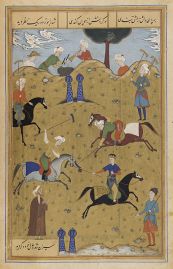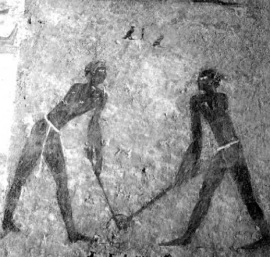7. Sticks around: The ancient ball games of Southern Asia and the Middle East
Sticklers that they are, good historians only like to go by facts that can be backed up by solid evidence, and therefore conclude that the Egyptians invented the ball. But that is about as silly as singling out a single country as the one where dogs first learned to fetch sticks.
 Although football-like games, such as the dhada of Rajasthan and the tremendous yubi lapki of Manipur, did exist in pre-colonial India, most ball sports in central and western Asia involved hitting balls with a stick, which may explain why field hockey was more readily adopted than football in much of the region.
Although football-like games, such as the dhada of Rajasthan and the tremendous yubi lapki of Manipur, did exist in pre-colonial India, most ball sports in central and western Asia involved hitting balls with a stick, which may explain why field hockey was more readily adopted than football in much of the region.
It is said that the greatest and oldest sport of all in this part of the world was stickball on  horseback, the game that led to modern polo, and where such places as Korea, Japan, India, Persia and the Ottoman Empire all had claims to the origins of a sport that played an important role in antiquity. However, it surely defies evolutionary logic for hockey on horseback to have existed before hockey on foot, and the reason for this distorted view of history seems to be that while polo-type sports formed an important part of the athletic culture of these nations and were widely documented, the older but less prestigious games played on the ground were generally ignored.
horseback, the game that led to modern polo, and where such places as Korea, Japan, India, Persia and the Ottoman Empire all had claims to the origins of a sport that played an important role in antiquity. However, it surely defies evolutionary logic for hockey on horseback to have existed before hockey on foot, and the reason for this distorted view of history seems to be that while polo-type sports formed an important part of the athletic culture of these nations and were widely documented, the older but less prestigious games played on the ground were generally ignored.
There is scattered evidence of hockey-like games being played from North Africa to India, such as the Algerian koona, the Ethiopian ganna, Persian chaughan and the khong kangjei of Manipur in modern-day India. And in Egyptian tombs, several images show people playing with balls, either juggling or playing what might be some kind of hockey, although these generally tell us a lot less about sport in the times of the Pharaohs than some people like to think. Most interpretations are ambiguous at best, and to move from these images to Robert Henderson’s famous theory that all western ball games were based on an ancient fertility rite requires quite a large leap of faith.
But that’s just the start of it concerning theories for how Middle Eastern ball games influenced global sporting culture. One is that the semi-legendary Tuatha de Danann that invaded Ireland at the Battle of Moytura were actually from Phoenicia, and that this was how hurling arrived in the country. But although plausible, all of this requires some impressive re-imagining of both Phoenician and Irish history and is impossible to state as fact.
 Another is the surprisingly convincing possibility that the Phoenicians once made it as far as South America. And if that was the case, then could it explain the origin of the hockey-like game called palin that is played by the Mapuche, and was known to the Spanish as chueca?
Another is the surprisingly convincing possibility that the Phoenicians once made it as far as South America. And if that was the case, then could it explain the origin of the hockey-like game called palin that is played by the Mapuche, and was known to the Spanish as chueca?
Again, it’s a fascinating theory, but one that’s very difficult to prove. Although the aforesaid Robert Henderson insisted that a sporting tradition based on an Egyptian head-cult spread across Asia, into the South Pacific and eventually made it to Peru and into North America, it is far more tempting to believe that the peoples of the New World were able to invent their own ball sports, as they did so many other wonderful things, without the help of supposedly more advanced cultures from the other side of the ocean.
Click here to read a preview of the complete chapter!
Posted on November 9, 2011, in Uncategorized and tagged ancient egypt, chueca, dhada, ganna, khong kangjei, palin. Bookmark the permalink. Leave a comment.


Leave a comment
Comments 0